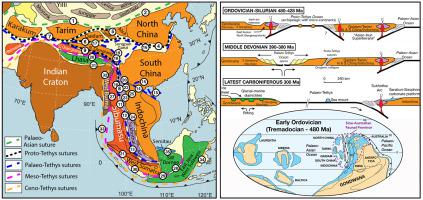Gondwana Research ( IF 7.2 ) Pub Date : 2021-02-03 , DOI: 10.1016/j.gr.2021.01.012 Ian Metcalfe

|
Four Tethyan ocean basins are recognised in Asia, the Proto-Tethys (Late Proterozoic - Silurian), Palaeo-Tethys (Middle Devonian - Late Triassic), Meso-Tethys (Middle Permian - Late Cretaceous) and Ceno-Tethys (late Middle Triassic- Eocene). Multi-disciplinary data, including ages of pelagic sediments, ocean plate stratigraphy, seamounts, ophiolites, blueschists, eclogites in accretionary complexes, volcanic arc and magmatic rocks found along suture zones of the Tethyan oceans are described and used to date the opening and closure of these oceans. The evolution of the Tethyan ocean basins in Asia illustrates that Asia has been a giant convergent zone for more than 500 million years and the Phanerozoic construction and evolution of Asia involved the opening and closure of Tethyan ocean basins and the collision and accretion of Gondwana-derived continental blocks and the Indian Craton. Subduction processes, arc and back-arc basin generation, and continent-continent and arc-continent collisions led to the principal orogenic events, basin development and related mineral and energy resource deposits recorded in Asia. Three major orogenic belts are recognised in Asia, the Central Asian Orogenic Belt, that relates to the evolution of the Palaeo-Asia Ocean, and the Tethyan (Tethysides) Orogenic Belt and the Alpine-Himalayan Orogenic Belt which relate to the evolution of Tethyan ocean basins. The principal Tethyan basin related orogenies in Asia are the Bhimphedian Orogeny (Ordovician-Silurian) that reflects the collision of major Asian continental blocks (“Asian-Hun Superterrane”) with Gondwana, the Indosinian (Cimmerian) Orogeny (Permian-Triassic) resulting from Palaeo-Tethyan subduction processes, collisions of Asian blocks and collision of the Cimmerian continent with Asia, and the Himalayan-Tibetan Orogeny (Cretaceous-Palaeogene) caused by subduction of the Meso- and Ceno-Tethys oceans and the Lhasa-Asia and India-Asia collisions.
中文翻译:

亚洲多个特提斯洋盆和造山带
亚洲公认有四个特提斯洋盆,即原始特提斯(晚元古代-志留纪),古特提斯(中泥盆纪-晚三叠纪),中观特提斯(中二叠纪-白垩纪晚期)和切诺特斯(中三叠纪晚期)始新世)描述了多学科数据,包括沿特提斯洋的缝合带发现的浮游沉积物的年龄,海床地层的年龄,海山,蛇绿岩,蓝岩岩,增生复合物中的榴辉岩,火山弧和岩浆岩,并以此来确定日期。这些海洋。亚洲特提斯洋盆的演化表明,亚洲是一个超过5亿年的巨大汇聚区,亚洲的古生代构造和演化涉及特提斯洋盆的开放和关闭以及冈瓦纳派生的碰撞和积聚。大陆块和印度克拉通。俯冲过程,弧和后弧盆地的产生,大陆-大陆和弧-大陆的碰撞导致了亚洲主要的造山事件,盆地发育以及相关的矿产和能源资源沉积。亚洲公认了三大主要造山带:与古亚洲洋的演化有关的中亚造山带;与特提斯洋的演化有关的特提斯(特提赛德斯)造山带和高山-喜马拉雅造山带盆地。











































 京公网安备 11010802027423号
京公网安备 11010802027423号